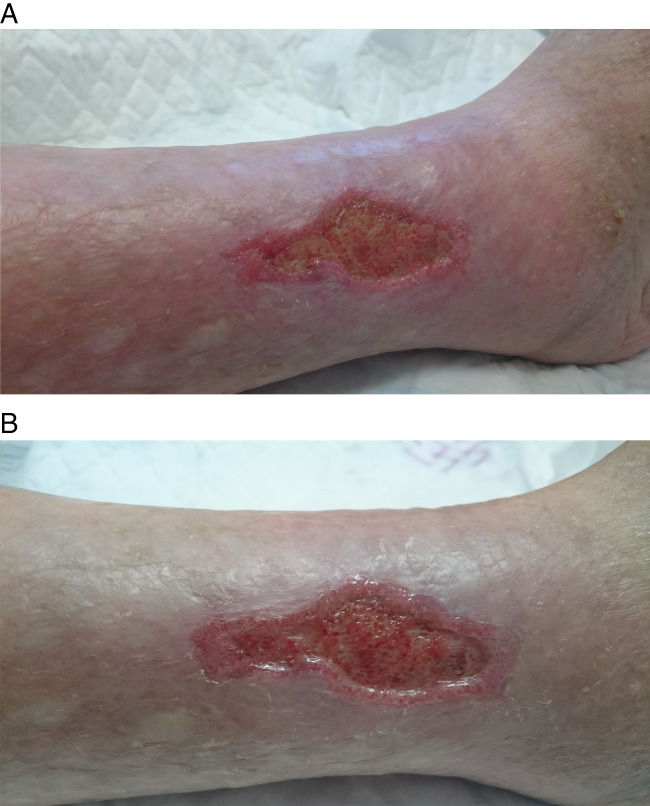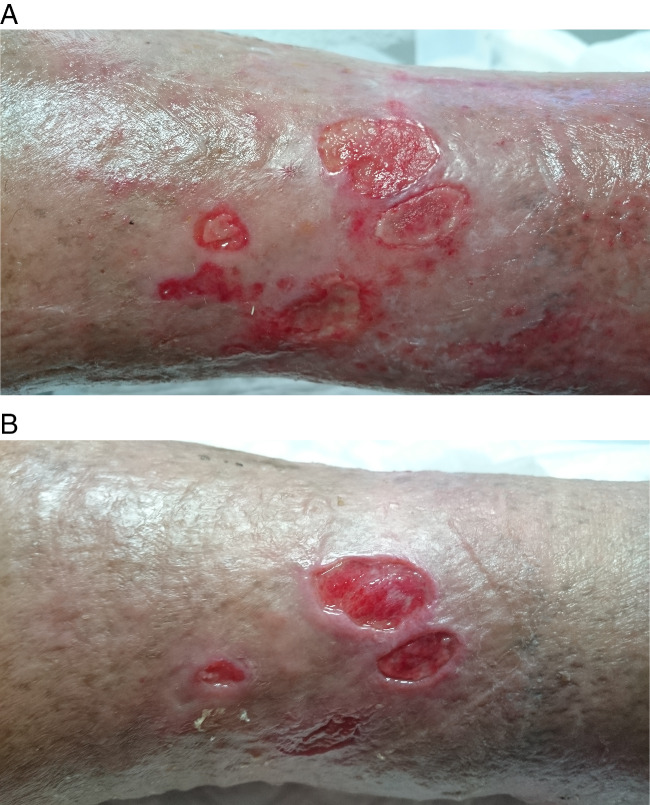Abstract
Several anaesthetic drugs have demonstrated antibacterial properties in vitro. Anaesthetics can primarily affect the cell wall of both susceptible and multi‐resistant bacteria. They may also have a synergistic effect with conventional antibiotics through an unknown mechanism. We present three cases of a chronic venous ulcer infected by multi‐resistant bacteria refractory to conventional systemic antibiotics, including Pseudomonas aeruginosa and methicillin‐resistant Staphylococcus aureus (MRSA). Treatment with topical sevoflurane was performed for 1 month without systemic antibiotics. Patients with an MRSA infection showed progressive improvement with negative culture at the end of the treatment. Multi‐drug‐resistant P. aeruginosa infection persisted at the end of treatment with positive culture. The local adverse events were mild and transient, including heat, pruritus and erythema. Topical sevoflurane may have an antibacterial effect on sensitive and multi‐resistant strains. It can allow more complete surgical cleaning, leaving a cleaner wound with less fibrin and necrotic tissue. This decreases the bacterial colonisation and therefore the infectious risk, the bad smell and the exudation. The simultaneous use of conventional antibiotics and topical sevoflurane can have a synergistic antimicrobial effect.
Keywords: Anaesthetic drugs, Antibiotics, Multi‐resistant bacteria, Sevoflurane, Ulcers
Introduction
Several anaesthetic drugs have demonstrated antibacterial properties in vitro. The anaesthetics ether, halothane, isoflurane and enflurane have a bactericidal effect on Staphylococcus aureus, Escherichia coli, Corynebacterium diphtheriae, Serratia marcerens, Proteus vulgaris and Pseudomonas aeruginosa. The halogenated anaesthetics are potent bactericides in liquid state but not in their gaseous state, and a direct toxic effect on the cellular envelopes is suggested 1.
Case reports
We present three cases of a chronic venous ulcer infected by multi‐resistant bacteria refractory to conventional systemic antibiotics. The first case is a 68‐year‐old male with multi‐drug‐resistant P. aeruginosa infection. The second is a 73‐year‐old woman with methicillin‐resistant S. aureus (MRSA) infection (Figure 1A). The last one is an 82‐year‐old female with an MRSA infection (Figure 2A). Written consent from the patients and permission from the Pharmacy Department were obtained for the off‐label use of topical sevoflurane on their leg ulcers. Cleanings every 48 hours was initiated, with the direct irrigation of liquid sevoflurane 1 ml/cm2 over the wound size. Treatment with topical sevoflurane was performed for 1 month without systemic antibiotics. Patients with an MRSA infection showed progressive improvement, with negative culture at the end of the treatment, but the wounds remained opened (Figures 1B and 2B). Multi‐drug‐resistant P. aeruginosa infection persisted at the end of treatment, with positive culture. The local adverse events were mild and transient, including heat, pruritus and erythema. No systemic adverse effects were detected.
Figure 1.

Chronic venous ulcer (CVU) with methicillin‐resistant Staphylococcus aureus infection (A) before and (B) after topical sevoflurane treatment.
Figure 2.

Chronic venous ulcer (CVU) with methicillin‐resistant Staphylococcus aureus infection (A) before and (B) after topical sevoflurane treatment.
Discussion
Martínez et al. report that sevoflurane has a bactericidal effect in vitro against S. aureus, P. aeruginosa and E. coli. Samples were obtained from patients for both susceptible and multi‐resistant strains. The authors propose that sevoflurane does not use the same pathways as conventional antibiotics and obviates the usual resistance mechanisms 2.
Ultra‐structural and biochemical studies support that anaesthetics can primarily affect the cell wall of both susceptible and multi‐resistant bacteria. They may also have a synergistic effect with conventional antibiotics by an unknown mechanism. They can alter cellular permeability by affecting the mechanisms of membrane transport. This effect may increase the susceptibility to the conventional antibiotic or the concentrations of the conventional antibiotic in the cytoplasm of the bacteria 1.
Gram‐negative bacteria are less resistant to the antimicrobial action of halogenated anaesthetics than Gram‐positive bacteria. Gram‐positive bacteria have a thickened peptidoglycan layer that hinders the diffusion of the anaesthetic into the cell membrane 1, 2.
An experiment analysed the in vitro effect of sevoflurane and isoflurane in its liquid form on strains of S. aureus, E. coli, P. aeruginosa, Klebsiella pneumoniae, Enterobacter cloacae, Actinetobacter baumannii and Enterococcus faecium. Isoflurane showed a faster and higher antimicrobial effect than sevoflurane against all the strains studied. Gram‐negative organisms were more susceptible. Enterococcus faecium was resistant to both agents. Isoflurane and sevoflurane exhibit antibacterial activity in vitro against pathogens resistant to conventional antibiotics 3.
Ferrera et al. reported a 61‐year‐old man with a cranioencephalic trauma who required several surgical interventions 4. Recurrent epidural abscesses were treated with surgical cleanings and antibiotic treatment. In the fifth infectious episode, a frontal epidural abscess was observed with cutaneous fistulisation. The cavity showed a positive culture for E. coli. Subsequently, weekly treatment was initiated with liquid sevoflurane at a dose of 5 ml through an intracavitary catheter. No adverse effects were described. The wound healed completely after 8 weeks of treatment. The recovery of the abscess was showed by imaging test after 15 weeks of treatment.
Rueda‐Martínez et al. reported a 43‐year‐old male with a personal history of liver transplantation secondary to cirrhosis due to hepatitis C virus 5. The surgical wound showed infection by multi‐resistant P. aeruginosa and S. aureus. Intravenous colistin was initiated, but it had to be discontinued because of impaired renal function. Subsequently, weekly treatment with 5 ml liquid sevoflurane was initiated through irrigation. A quick analgesic effect allowed adequate debridement. After 5 weeks, the wound had a favourable clinical course with no signs of inflammation or purulent drainage. The culture was positive for S. aureus (moderate number) and negative for P. aeruginosa.
We previously reported a 73‐year‐old woman with a personal history of arterial hypertension, morbid obesity, type 2 diabetes mellitus, apnea‐hypoventilation syndrome, chronic renal failure and ischaemic heart disease 6. She showed very painful vascular ulcers in her right lower limb. The wound was infected by MRSA. Treatment was performed with daily cures, topical antibiotics and several systemic antibiotics with no improvement. Daily treatment with topical sevoflurane was initiated. An intense, quick and lasting analgesic effect was observed. This allowed surgical cleaning and debridement of necrotic tissue. After 21 days of treatment, most of the leg ulcers were healed.
We consider that topical sevoflurane may have an antibacterial activity for sensitive and multi‐resistant strains. The mechanism of action is unknown. Topical sevoflurane can allow more complete surgical cleaning, leaving a cleaner wound with less fibrin and necrotic tissue. This decreases the bacterial colonisation and therefore the infectious risk, the bad smell and the exudation. The simultaneous use of conventional antibiotics and topical sevoflurane can have a synergistic antimicrobial effect.
In conclusion, topical sevoflurane may be a novel and useful therapeutic alternative in wounds infected with multi‐drug‐resistant bacteria.
References
- 1. Batai I, Kerenyi M, Tekeres M. The impact of drugs used in anaesthesia on bacteria. Eur J Anaesthesiol 1999;16:425–40. [DOI] [PubMed] [Google Scholar]
- 2. Martínez M, Gerónimo M, Crespo MD. Actividad bactericida del sevoflurano frente a Staphylococcus aureus, Pseudomonas aeruginosa y Escherichia coli. Enferm Infecc Microbiol Clin 2009;27:120–1. [Google Scholar]
- 3. Martínez‐Serrano M, Gerónimo‐Pardo M, Martínez‐Monsalve A, Crespo‐Sánchez MD. Antibacterial effect of sevoflurane and isoflurane. Rev Esp Quimioter 2017;30:84–9. [PubMed] [Google Scholar]
- 4. Ferrara P, Domingo‐Chiva E, Selva‐Sevilla C, Campos‐García J, Gerónimo‐Pardo M. Irrigation with liquid sevoflurane and healing of a postoperative, recurrent epidural infection: a potential cost‐saving alternative. World Neurosurg 2016;90:e1–5. [DOI] [PubMed] [Google Scholar]
- 5. Rueda‐Martínez JL, Gerónimo‐Pardo M, Martínez‐Monsalve A, Martínez‐Serrano M. Topical sevoflurane and healing of a post‐operative surgical site superinfected by multi‐drug‐resistant Pseudomonas aeruginosa and susceptible Staphylococcus aureus in an immunocompromised patient. Surg Infect (Larchmt) 2014;15:843–6. [DOI] [PubMed] [Google Scholar]
- 6. Imbernón A, Blázquez C, Puebla A, Churruca M, Lobato A, Martínez M, Aguilar A, Gallego MA. Chronic venous ulcer treatment with topical sevoflurane. Int Wound J 2016;13:1060–2. [DOI] [PMC free article] [PubMed] [Google Scholar]


